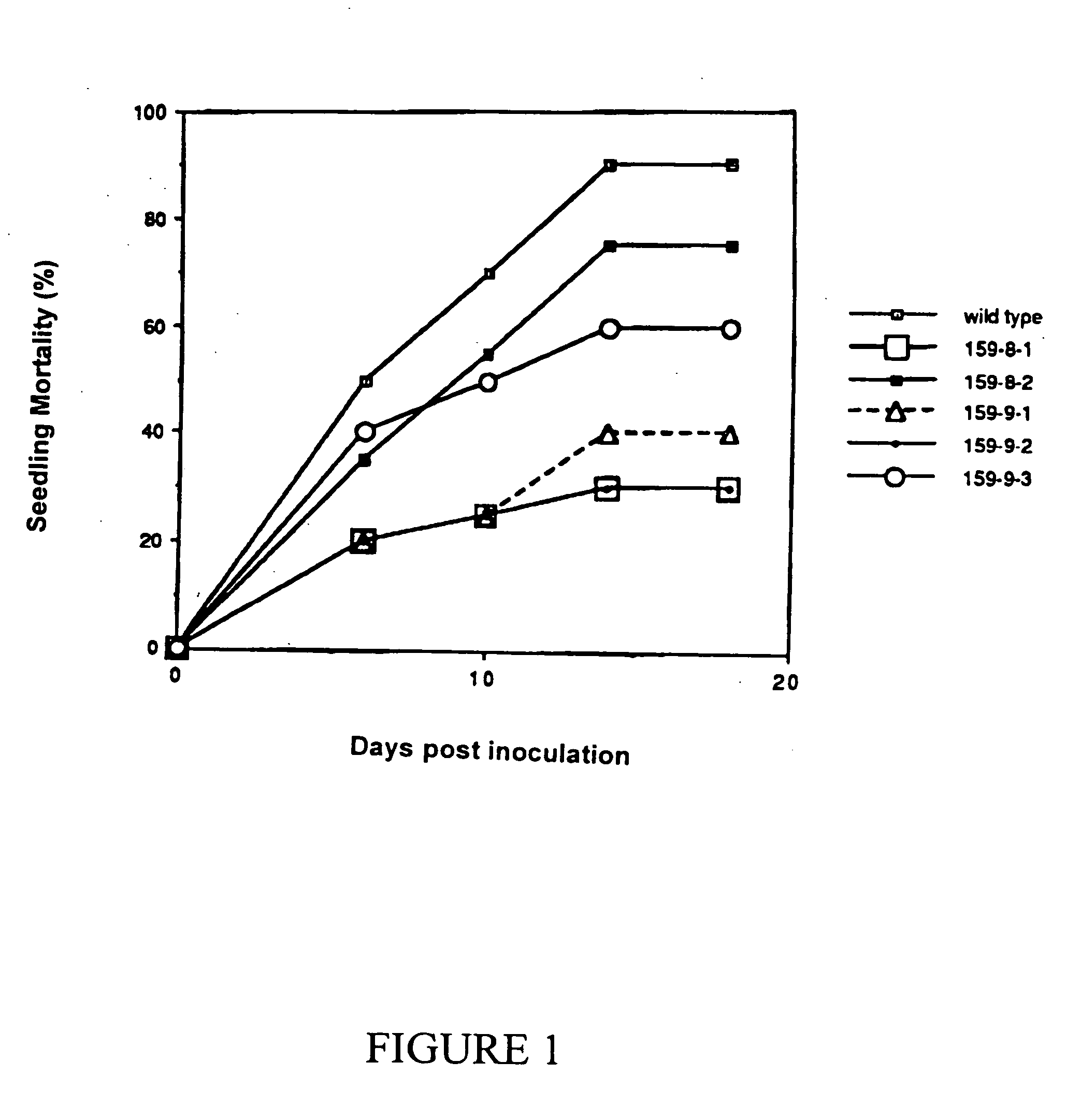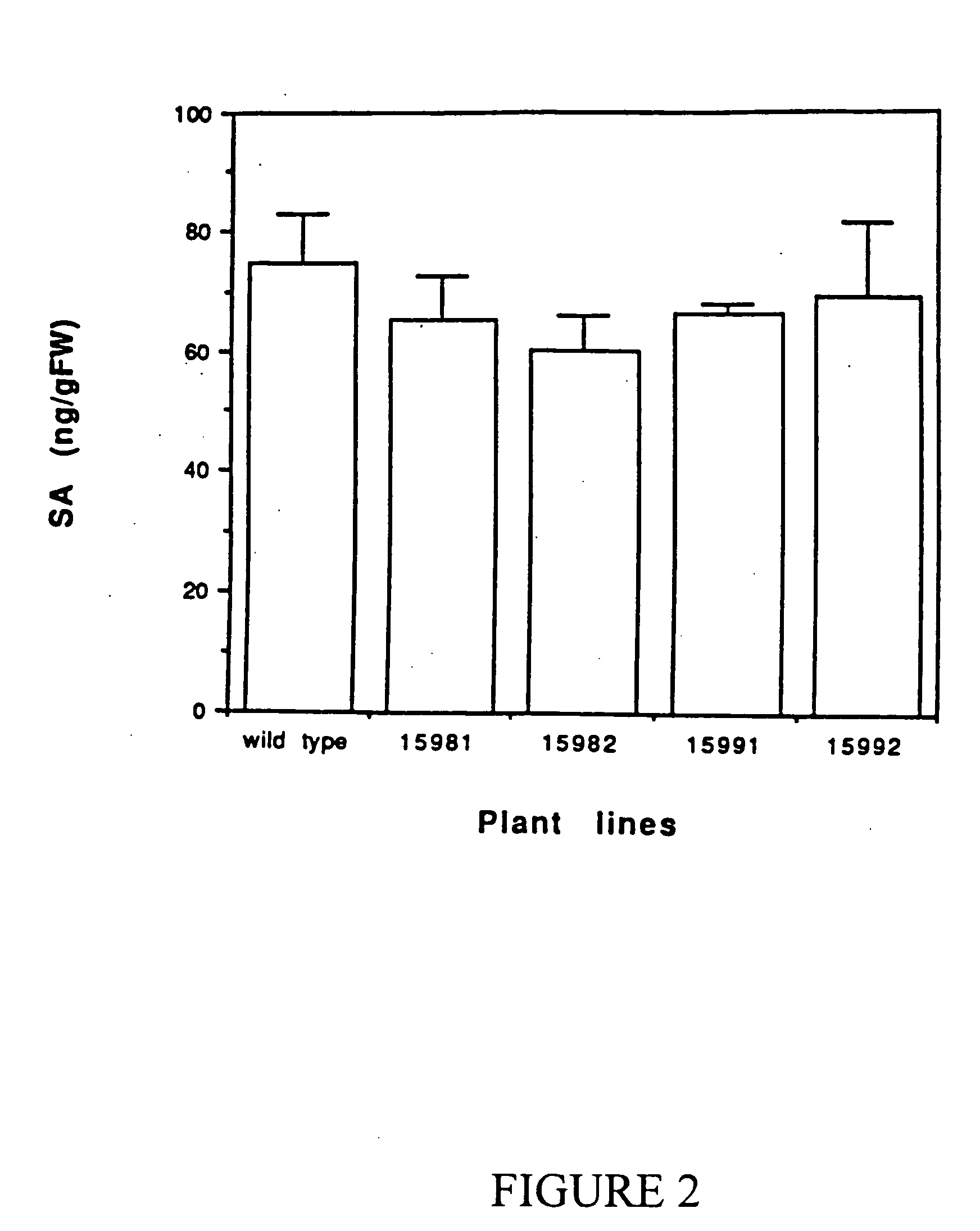Transgenic plants producing a pap II protein
a technology of pap ii and plant protein, applied in the field of agricultural biotechnology, can solve the problems of reducing the economic value of commercially valuable agricultural crops, increasing the cost of goods to the end purchaser, and increasing the cost of goods
- Summary
- Abstract
- Description
- Claims
- Application Information
AI Technical Summary
Benefits of technology
Problems solved by technology
Method used
Image
Examples
example 1
Cloning of PAP II Gene and Comparative Toxicities of PAP I and PAP II in Transformed Tobacco
[0041] PAP was purchased from Calbiochem, PAP II was a generous gift of Dr. James Irvin. Polyclonal antibodies against PAP and PAP II were raised in rabbits. PAP II IgG was purified using a protein A affinity column (Bio-Rad, Hercules, Calif.). Alkaline-phosphatase (Sigma, St. Louis, Mo.) was conjugated to PAP II IgG by glutaraldehyde (Harlow, et al., “Immunoblotting”. In: Antibodies: A Laboratory Manual, pp. 471-510, Cold Spring Harbor Laboratory, Cold Spring Harbor, N.Y. (1988)).
Cloning of PAP II cDNA
[0042] Total RNA was isolated from 1 gram of pokeweed leaves using Tri-Reagent (Molecular Research Center, Cincinnati, Ohio). Poly A+ RNA was isolated using an oligo-dT affinity resin (Stratagene, LaJolla, Calif.). The cDNA library was constructed from 5 μg total mRNA with a lambda ZAP-cDNA synthesis kit according to the manufacturer's instructions (Stratagene, LaJolla, Calif.). The cDNA li...
example 2
Expression of Various PAP II Mutants in Yeast
Construct for Expression of PAP II in Saccharomyces cerevisiae
[0070] Plasmid containing the wild PAP II (NT148) was digested with PvuII and XhoI. Following electrophoresis in low melting agarose gel, the restriction fragments containing the PAP II inserts were purified and ligated to the yeast expression vector TKB175 digested with SmaI and XhoI. The resulting plasmid NT264, contained the selectable marker TRP and PAP II downstream of the galactose-inducible promoter, GAL1.
Site-Directed Mutagenesis of PAP II cDNA.
[0071] Point mutations were introduced into PAP II by site-directed mutagenesis using a Quick-Change™ Mutagenesis Kit (Stratagene) following the manufacturer's instructions. In each mutagenesis experiment, two complementary primers containing a desired point mutation were designed. The PCR mixture contained 125 ng of each primer, 100 ng plasmid DNA template containing PAP II cDNA(NT264), 0.5 mM dNTP and 3 units of Pfu DNA p...
example 3
Expression of PAP II in Turfgrass
[0081] An expression vector was constructed for turfgrass transformation which included the PAP II cDNA downstream of the maize ubiquitin promoter and intron in the plant expression vector NT168. Downstream of the PAP II gene, polyadenylation sequences from the small subunit of ribulose 1,5 bisphosphate carboxylase E9 gene were present. Transgenic turfgrass plants were generated using particle bombardment. Southern blot analysis identified several independently transformed lines containing PAP II sequences. Immunoblot analysis indicated very high levels of expression of PAP II protein in transgenic plants. The levels of expression of PAP II were greater than the levels observed with nontoxic PAP mutants. Transgenic plants were indistinguishable from wild type plants in their physical characteristics and appearance, indicating that PAP II expression was not toxic to turfgrass.
[0082] PAP II confers broad spectrum resistance to numerous pests. This re...
PUM
| Property | Measurement | Unit |
|---|---|---|
| pH | aaaaa | aaaaa |
| temperature | aaaaa | aaaaa |
| temperature | aaaaa | aaaaa |
Abstract
Description
Claims
Application Information
 Login to View More
Login to View More - R&D
- Intellectual Property
- Life Sciences
- Materials
- Tech Scout
- Unparalleled Data Quality
- Higher Quality Content
- 60% Fewer Hallucinations
Browse by: Latest US Patents, China's latest patents, Technical Efficacy Thesaurus, Application Domain, Technology Topic, Popular Technical Reports.
© 2025 PatSnap. All rights reserved.Legal|Privacy policy|Modern Slavery Act Transparency Statement|Sitemap|About US| Contact US: help@patsnap.com


